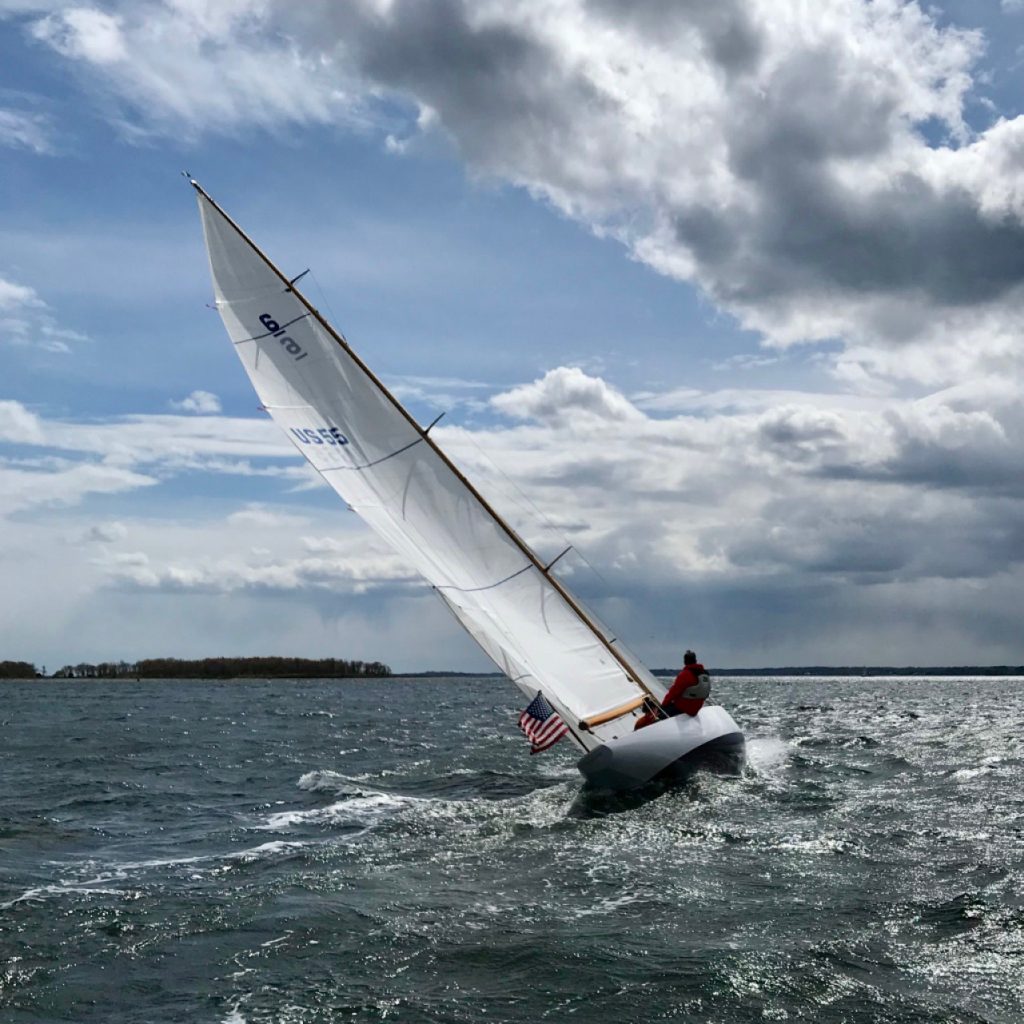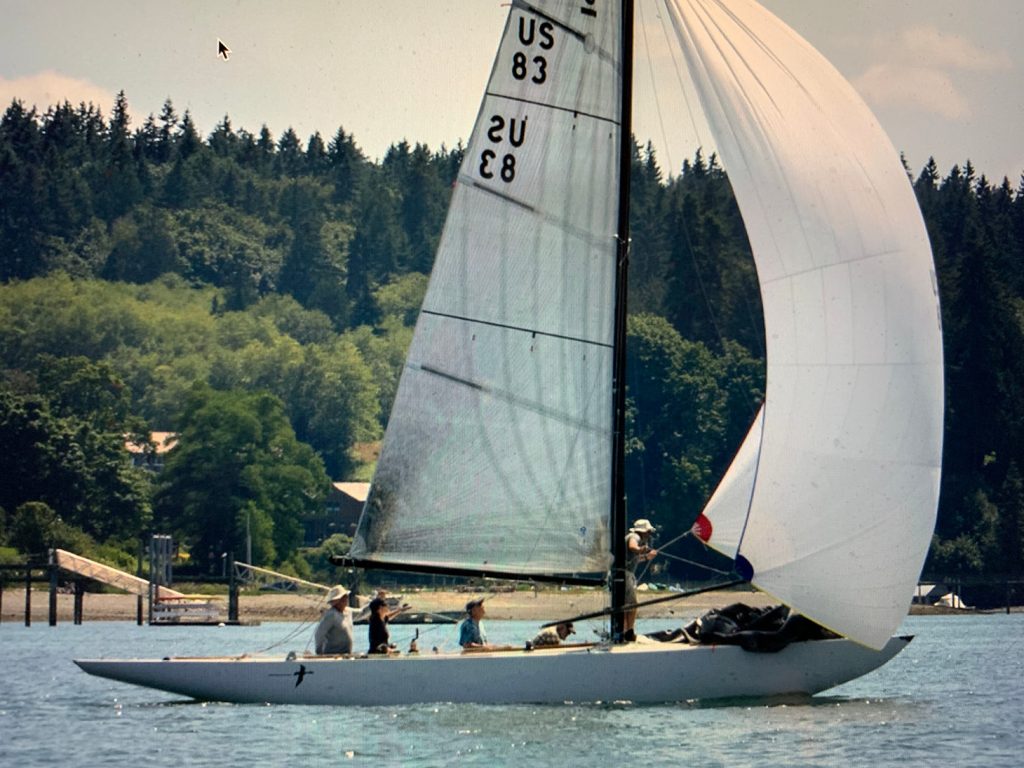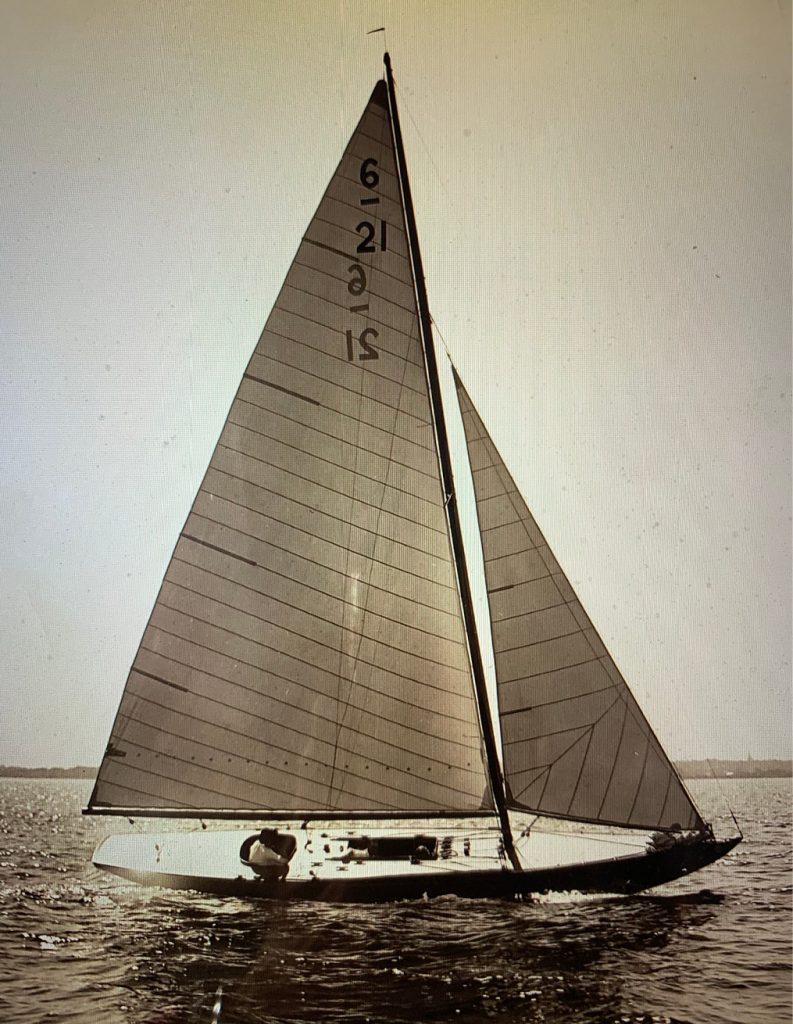In Oyster Bay, New York, in the basement of the oldest yacht club in America, born 1871, there is a vault. In that vault and on the paneled walls of that club is the history of the oldest, most venerable racing class on the continent, in photo and half model. The club is the Seawanhaka Corinthian Yacht Club. The class is the International Six Metre.
From the 19th century roots of the boat that evolved into the America’s Cup 12 Metre, we tell a story of rules and breakaway designs, of Gilded Age family owners and Corinthian skippers. When noted writer John Rousmaniere publishes his widely anticipated history of Seawanhaka for its upcoming 150th Anniversary this fall, we will expect yet another chapter of the Sixes’ long history.
The Dawn of the Sixes starts in the 1890s with the swirl of controversy over who makes the rules in yacht design. Our old friend, Capt. Nat Herreshoff, has his finger on the scale of the prevailing rating system of the time, derived from Seawanhaka’s own homegrown rule, while he manufactures a torrent of naptha launches, American daysailers and America’s Cup behemoths.
Meanwhile, in 1907, a group of international sailors decides to keep records of their designs, their race records, and their rules. They form an association, the International Six Metre Association. Go forward a century. As of 2018, the website of the class catalogues the vital statistics and photos of the estimated 1,500 Sixes built around the world, about 300 here in the U.S. A full-time archivist scours the world for information and better, photos, of vintage Six Metres.
The Rules of Rating
The common wisdom is that Sixes developed over three ages, defined by commonly accepted design rules and scantlings, the building codes of a keelboat development class. A short field guide to Sixes on the water is as follows:
1890 to 1920: First Generation, built to the Seawanhaka cum Universal Rule, low and flat, gaff rigged, scowlike.
1921 to 1930: Second Generation, as defined by designers like Hoyt, Fife, Crane, and the debut of the new kid on the block, the designer who dominated the interwar period, Olin J. Stephens
1930 to the Second Word War: Third or “Modern” Generation, many of which sail today in America, England, and Scandinavia with their native designers
From 1907 on, a Six Metre was built to the same rule as the 12s – the International Rule. These are boats built from an equation. The history of that formula comes from half a century of trying to figure out how to have boats of different shapes and sizes race against each other.
Here was my own personal experience on ratings. I had a Blue Jay as a kid; my neighbor had a Snipe. We were forever trying to figure out a fair way to race together. The Blue Jay was lighter; the Snipe had a big jib. We never figured it out.
Not surprising because from the middle of the 19th century on, rating rules have been the raison d’aitre of designers and the bete noire of sailors. In Britain, yacht ratings were based on tonnage, no matter the draft. So British boats evolved narrow and deep.
In America, the Seawanhaka Rule favored stability of form, creating a broad and shallow hull, the “skimming dish.” The 202-foot monster Reliance launched for the Cup in 1903 was the ultimate skimming dish. It was in 1903 that Herreshoff adopted his own form of “Universal” rating rule from the factors of the Seawanhaka.
The International Rule was different. It took a page full of measurements and calculated a number. That number defined your class. They were the Metre classes: 23, 19, 15, 12, 10, 8, 7, 6, and 5. Today, we only hear about 12s, 8s and 6s.
For the first half of the 20th century, the Herreshoff Alternative, cum Universal Rule stood in opposition to the International. The two rules did not get hitched until 1970. The marriage was conferred then as the IOR.
The Six Metre models and photos throughout Seawanhaka belonged to a new era of Corinthian sailor, the amateur owner-skipper. Until the end of the 19th century, yachts had been owned by heads of state supplemented by elite Gilded Age magnates. It was Downton Abbey gone sailing. In contrast, New Sailing Man was an enthusiast; his boat was a sports car, not a limo, a recreational vessel with perhaps a few professional crew members supplying “Norweigan steam.” Designers and builders responded to this need for craft to be handled with a reduced crew and driven by amateur enthusiasts.
The Age of the Gentleman Designer was the result. The names were Hoyt, Whiton, Paine, Crane and others. In the wake of Herreshoff, these were self-taught naval architects who took the helm themselves for their well-heeled owners eager to have at anchor a stable of exotic racing yachts.
Clinton Crane: The Roaring Twenties Designer
Clinton Crane epitomized that designer for this new racing set. More Stanford White than Captain Nat, Gold Coast, Long Island vs. Bristol, Rhode Island, he was a Harvard engineering graduate, class of 1894. After getting a hands-on PhD in propellers and the new gasoline engine at the University of Glasgow, Crane returned to Oyster Bay to design for himself and his friends.
In 1899, he took an assignment from the St. Regis Yacht Club to design a class of wooden sloops for light Adirondack lake winds. The so-called “Idems” are the first recorded one-design keelboat. These unique 32-foot gaff-riggers continue to race, some even skippered by relatives of the original owners.
In 1896, Crane had created a “half rater” design for the Seawanhaka Cup, the oldest active yachting trophy in America, established for match racing. The boat lost but his reputation grew, and Crane went on to pen the early iconic designs of the post-World War I yachting boom. He came to dominate the American Six Metre designs of the mid- to late 1920s with his sleek, long-lined boats like Clytie, Lenai, Akeba and Lucie. In 1931 his masterpiece, Lucie II, became the ride of a young gun, Briggs Cunningham, and is still winning today under owner Matt Brooks.

Lucie II, US 55, Briggs Cunningham’s special Six, hard on the wind
British American Cup, The
For Crane’s most active years, the goal was to deliver boats that would qualify for the growing number of international competitions, or “Cups.” As the 1920s dawned, the cousin of the 19th century Seawanhaka Cup, the British American Cup, took the stage and created the sport of team racing. It all started when the current British Yachting Empire challenged the former pesky Colonists to a friendly race in the Solent in 1921.
A memo obtained from the Royal Yacht Squadron, the Castle, Cowes, Isle of Wight, PO 31QT, announcing the 1995 BAC in Sigma 33s with five crew, tells the backstory of the event:
“The British American Cup takes place in Cowes between 11th and 15th September 1995. The Series will be sailed over a maximum of seven races.”
“The British American Cup, one of the oldest and most prestigious in team racing, started back in 1921 when the Clubs of the Royal Yacht Squadron, the Royal Thames, the Royal London and the Royal Victoria Yacht Clubs were joined by the Royal Clyde and the Royal Northern Yacht Clubs for a new competition. The agreement under which the races were to be held was drawn up between the British clubs and the Seawanhaka Corinthian Yacht Club from Long Island near New York. Racing has been taking place between these two groups ever since, open to all comers.” So collegial and democratic, it seemed.
The first regatta took place on July 21,1921 and was won by Britain. The outcome of the first series was deemed such a success, with Britain taking possession of the first trophy following wins in 1923 and 1924 that a second series was proposed. For sure, it was a quirky scoring system. Each team has four boats, high point scoring wins. You alternated race sites (Long Island Sound and Cowes). Whoever wins three times retires the trophy. After the Brits won in 1924 with three of four years wins, the next series started on the Clyde in 1928 and the British won by three races to one. The Clyde proved to be the last time that Britain won the Cup for many years.
Olin Stephens: All-American Designer
One of the reasons for that American dominance was listed in the British Notice of Race for the BAC, which read:
“The decline of 6 Metre racing on the Solent and the rise of a young designer by the name of Olin J. Stephens combined to create an era of American supremacy.” For all of you keeping score, on the Seawanhaka trophy wall, I counted nine British American Cups on the shelf. Yes, that is dominance.
As Crane was to Nat Herreshoff, with a generation between them, a young, self-taught designer was to Crane, Olin Stephens. He was born April 13, 1908. Capt. Nat was 56; Crane was 36. Olin was brainy and laconic with a simple goal. “I was lucky,” he said later. “I had a goal. As far back as I can remember, I wanted to design fast boats.”
With Crane’s encouragement, Stephens became the Babe Ruth and Lou Gehrig of naval architects. He was the Complete Boat Designer, who embraced technology as Herreshoff had, and would transform the role of the yacht designer from the traditional artist of hull and rig to a manager of math and physical sciences applied to scientific yacht design. The test tank was his sandbox. A designer for the modern age, he had a stylistic impact on the way boats are put together, under and over the waterline.
Raised in the Bronx, he learned his sailing on Cape Cod with father Rod and younger brother, Rod, Jr. His formal education was to start at MIT in 1926, but an illness sent him home and to work in the Nevins Shipyard on City Island by 1928. His first published design, Ghost, appeared in the January 1928 edition of Yachting, and from there to the 1938 launching of Goose flowed a set of the fairest Sixes.
“In any design,” Stephens wrote, “the most important factors of speed seem to be long sailing lines and large sail area, with moderate displacement and small wetted surface. Then comes beauty, by which is meant clean, fair, pleasing lines.”
In 1929, Olin had set up an office next door to Nevins with Drake Sparkman, a successful broker, to form Sparkman & Stephens, Inc. (S & S) When his own father commissioned S & S Number 4, the 52-foot Dorade, it looked like he was thinking 6 Metre with a tall Bermuda rig, narrow beam, lead ballast, and sophisticated steam-bent frame. Dorade’s win in the 1931 Transatlantic Race earned the family a ticker tape parade up Broadway on their return.
In 1929, just 21, Olin had designed his first Six, Thalia, for Lewis G. Young of Rye. In her 1930 Bermuda racing, Thalia had issues. But in that year, into the teeth of a gathering Depression, he brought out Comet, Meteor and Cherokee, with Cherokee standing out. When the British contested the BAC that season, the team made up of Lucie and Mars, the two Crane boats, Aphrodite, designed and sailed by SCYC’s Sixes leader C. Sherman Hoyt, and Olin’s new Cherokee took four straight from the British.
Cherokee went on to win the YRA title, was runner up in the 1931 Gold Cup, and was still fast enough in 1935 to make the U.S. team. Between 1930 and 1936, American Sixes had not lost so much as a race to British-built craft. But it was Stephens’ Sixes of the late 1930s, boats like Goose and Llanoria, that cemented his reputation as the designer of the 20th century.
The story of Goose has its own intrigue. Launched in spring 1938, she had unidentified construction issues that required rework. The back of the boat came off, and the original transom was donated to Seawanhaka, where it is displayed on the south end of the club’s massive dining room fireplace.
Both Goose and Llanoria had defended the Seawanhaka match race cups in the post-World War II era. Nearly 80 years after splashing at Nevins Boatyard, a revamped Goose sailed the 2017 World Championships in Vancouver.

Goose, the fastest Six and Olin Stephens’ best
Briggs Cunningham: The Sixes Sportsman
No story of Sixes can be complete without a story or two on Briggs Cunningham. Born a year before Olin in Cincinnati, Ohio, he came from a family that could afford boats and cars, and he curated and raced both. His father was the chief financier of Procter & Gamble; his godfather was the founder.
Cunningham is the only sailor I know who has a piece of sailing hardware named specifically for him, the Cunningham. (I’ve never heard anyone say, “Trim that Elvstrøm,” “Ease that Melges,” or “Get your foot off that Jobson!”)
Cunningham was a driven sailor and an obsessed car racer, and was as proud of his many 24 Hours of Le Mans as his skippering of Columbia in the first 12 Metre win in the America’s Cup, in 1958. As a Yale undergraduate, he was sailing 8 Metres and S Boats and at his home club, Pequot Yacht Club in Southport, Connecticut, dipping into the early Star Class. In 1928, fresh out of school, Briggs came on the scene as part owner of an 8 Metre with his future father-in-law, E.T. Bedford, a Standard Oil executive and the original marketer of Vaseline. He married his partner’s daughter, Lucie Bedford, whom he would always claim taught him to sail and was a better sailor.
The Six was his ride. In 1929, he bought the Crane-designed Akeba, which became Lucie I. After barnstorming Europe with her, he returned as one of the four members of the 1931 BAC team. His name is on the massive commemorative trophy for the team in the Seawanhaka dining room. His 1931 Lucie II was the “pace car” for the U.S. Six Metre team for years and is still winning races today under Matt Brooks, who owns a Picasso and a Matisse in the form of Stephens’ Dorade and Crane’s Lucie II.
The Cunningham legend persisted into the 12 Metre era, when he filled in as helmsman on Columbia when chief Corny Shields, Sr. suffered a heart attack. The story is that after polishing off the British Sceptre in four straight races, he went to a pay phone and called his race manager at Watkins Glen, where his driver had just won the main race. As he was returning to his Columbia, a reporter approached him and commented, “Briggs, that was a fine race,” to which he replied, cars on his mind, “That is what I hear. I wish I could have seen it.” Classic and classy, Briggs would go on to adopt S & S’s schooner Brilliant for his own and eventually donate her to Mystic Seaport Museum.

Madcap sails off Seawanhaka Corinthian YC in 1924. She is owned today by Hugh Jones.
Sixes Census 2020
A recent tally of the world fleet of Sixes from the international website is updated regularly. Sixes ceased to be Olympic boats after 1952, but they continue to be highly prized racers. How many are there?
• Sixes built since 1907: 1,550
• Classics built: 1,348
• Moderns (defined as “since WWII”) built: 101
• Classic reproductions (built at IYRS and other yards; most Sixes enthusiasts choose to renovate an existing boat): 3
• Sailing or racing actively: 135
• Lost (This is the only class website with a Lost and Found section): 0
• Found: 7 including boats in South Africa, New Zealand, Austria and France
Result? At any time, a Six is being reborn somewhere in the sailing world, from Newport to Seattle to Australia to Africa. Keep your eyes open. ■
Tom Darling starts his second year of his podcast Conversations with Classic Boats, which is available on Apple Podcast, Google Podcast and Spotify as well as the website at conversationswithclassicboats.com. You can also hear episodes via SpinSheet, Scuttlebutt Sailing News, and WindCheck. Community sailing groups such as Sail Newport and New England Science & Sailing also distribute episodes of Conversations with Classic Boats.
Sources: Sewanhaka Corinthian YC Archives, Hugh Jones
All This and Sailing Too, Olin Stephens biography
International Six Metre Website



